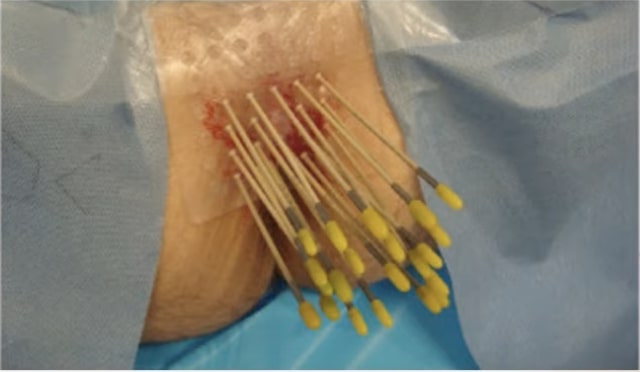When it comes to treating prostate cancer, surgery is the first thing that comes to mind.
But there are ways to treat it, and one of them is brachytherapy.
What is Brachytherapy for prostate cancer?
Brachytherapy is a procedure to treat prostate cancer by inserting tiny radioactive seeds inside your prostate.
These seeds give off low doses of radiation, which will kill your prostate cancer cells.
In brachytherapy, radiation comes from within the prostate (as opposed to external radiation).
Brachytherapy can be temporary (seeds are removed later) or permanent (seeds stay but they get less radioactive over time).

Advantages
Brachytherapy has fewer side effects than surgery and it’s shorter than external radiation.
Who is a good candidate for brachytherapy?
Brachytherapy isn’t for everybody. It works best for:
- Stage. Best for early-stage cancer (they tumor hasn’t spread).
- Health. Patients should be in good overall health to withstand the procedure.
- Prostate size. It works better in larger prostates. Placing the seeds in small prostates can be challenging.
- Pre-existing problems. Patients should not have pre-existing urinary or rectal problems; these symptoms will worsen after treatment.
Step-by-step process
- Planning: First, you’ll get an MRI to locate the tumor inside your prostate gland. That way, they’ll know how many seeds they need and where to place them.
- Implantation: You’ll get your seeds inserted as an outpatient, so you won’t spend any nights in the hospital. They’ll use local or general anesthesia, so you’ll barely notice a thing.
For this process, you will lie on your back with your legs in stirrups, similar to a pelvic exam position.
Then, your doctor will insert the seeds through your perineum guided by an US. - Confirmation: You’ll get a new MRI to make sure the seeds are in the right place.

Some precautions
Most patients can return home on the same day. However, you must avoid close contact with pregnant women and young children (to protect them from radioactivity).
How effective is it?
90% of low-risk patients get cured.
In intermediate-risk patients, 80% get cured using a combined strategy (external radiation + brachytherapy).
So, how do you make sure the therapy actually worked?
- PSA: Your PSA will go down dramatically after treatment. It will not be 0, but it will be much lower than before. If your PSA is stable or declining, that’s a good sign. If your PSA starts going up, there might be a relapse.
- MRI: We use MRIs to monitor your cancer status. It shows if your tumor has spread or come back.
Side effects
There are some potential side effects with prostate brachytherapy:
- Urinary symptoms: You might need to pee more often or feel the need to pee urgently.
There can be blood in your urine, but it usually goes away within a few weeks. - Rectal Symptoms: Some patients have rectal discomfort and bleeding, but it’s usually mild and gets better on its own.
- Erectile Dysfunction: brachytherapy can cause erectile dysfunction, even though it’s less common than with surgery. Sometimes, it happens a few months after the procedure.
- Bowel Symptoms: You may get changes in your bowel habits or diarrhea, but these are usually mild and temporary. Sometimes, your rectum can get swollen (proctitis), causing discomfort and bleeding.
- Infection: Infection is a possible risk, especially during the procedure. Nevertheless, you will get antibiotics to reduce this risk.
- Urinary Retention: Some people can’t empty their bladder after the procedure. This is usually temporary, but you may require catheterization or medication.
- Delayed Radiation Effects: Some side effects may happen years after treatment. It’s mostly urinary symptoms and rectal inflammation.
- Seed Migration: It’s uncommon, but seeds can move outside your prostate. If it happens early on, you may need additional treatment.
When to choose brachytherapy vs. others
| Aspect | Brachytherapy | Surgery (Prostatectomy) | External Radiation |
| Invasive? | Minimally invasive | Invasive | Non-invasive |
| Treatment Duration | A single day or few sessions | Surgical procedure, then a recovery period (weeks) | Daily treatments over several weeks |
| Cure? | For low and some intermediate-risk prostate cancers | Potential for cure when entire prostate is removed | For various stages, including localized and locally advanced |
| Quality of Life | Lower risk of incontinence and bowel problems compared to surgery | Potential changes in urinary and sexual function | Similar side effects to brachytherapy |
To sum it up
Brachytherapy is a great way to treat prostate cancer. It’s less invasive than surgery and has less side effects. Also, it’s shorter than external radiation.
It’s not for everybody, but it works excellent for localized cancer in large prostates.
All in all, it’s a great option to consider.
Leave a Reply